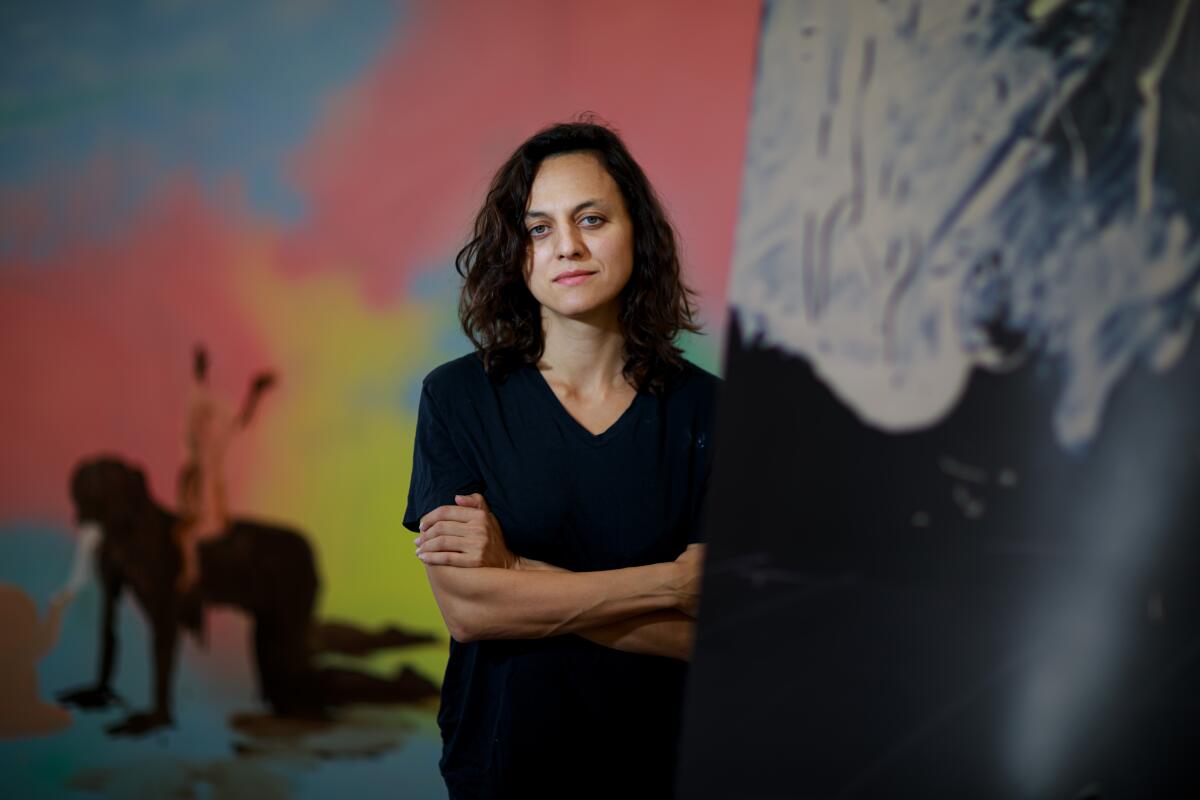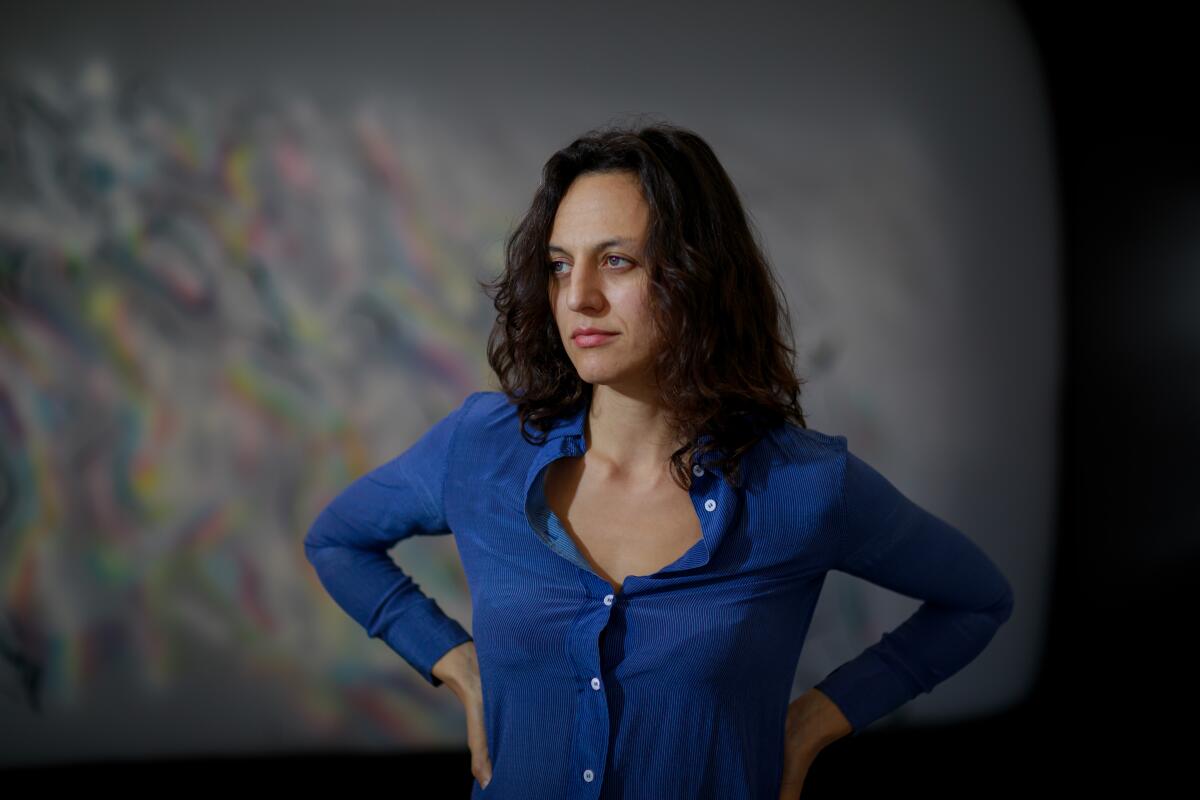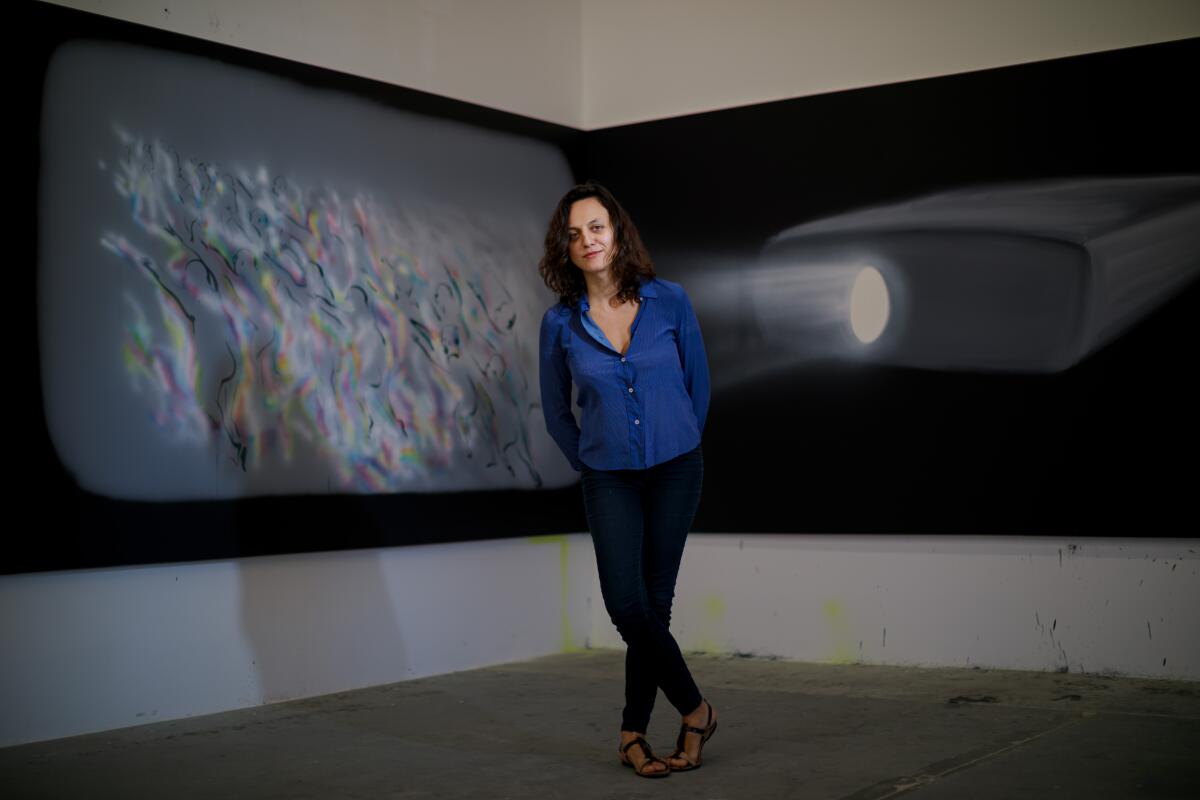Feral babies and moms made of poo: How painter Tala Madani tweaks Western art

When painter Tala Madani returned to her studio after the birth of her second child and faced a blank canvas for the first time in eight months, she was worried it might well remain blank.
“I had,” she recalls matter-of-factly, “no ideas.”
Eager to paint something, anything, she pressed on.
“I thought I’ll paint a woman holding a child,” she says, seated in the middle of her orderly workspace in L.A.’s El Sereno neighborhood. “I was like, puking, painting it. I was like, omigod, how cliché! So I smeared her away and in smearing her away, I started to let the child smear her away.”
In the process, the mother figure began to look as if she’d been covered in excrement.
“And, I was like, this is interesting,” Madani says. “That, to me, could exist ... I was thinking of a mom that is literally made of poo.”
In her subject matter, the Los Angeles-based artist, 37, has never shied away from the body’s baser functions. In addition to poop, Tala Madani’s paintings have featured lonely sad sacks who vomit rainbows, feral infants who sketch with urine and pudgy everymen who ejaculate patterns worthy of Abstract Expressionist paintings. You might also see a circle of middle-aged bureaucrat types, flashlights in their mouths, beams of light emerging from collective anuses.
Her art can be abject. “Abjectness is the opposite of being pretentious,” says Madani.
But her art can also be ferociously funny. Sometimes, in fact, the artist will find herself chuckling as she produces a work. “That’s not the education of Yale,” she says with a laugh, referencing the place she received her master of fine art.
Madani explores the idea of the crappy mother figure in a newly opened exhibition at David Kordansky Gallery in Los Angeles, titled, appropriately enough, “S— Moms.”
Produced largely over the last year, these are paintings that play on the notion of the failed mom or bad mom: “I was thinking about my own phobias of failing as a mother,” she says.
The works also touch on the physical realities of motherhood. “The proximity of mothering to all of the body stuff,” explains Madani. “You have to become really close and intimate with it and befriend it.”
The series also takes a jab at a common trope in Western art history: the saintly and perfect Madonna and child.
“I am breaking, in a way, the Madonna by making her poo-y,” she says. “We have to get into the iconoclasm of the Madonna.”
As with Madani’s larger body of work, the paintings of her excrement moms are about more than the crude scenarios depicted on their surface. They channel emotions such as yearning, fear, solitude and the icy sensations that come with being trapped — trapped in rooms or trapped in loops of destructive behavior. (This comes to riotous life in a half-dozen painted animations by the artist that are also part of the show at David Kordansky, including one that involves a solitary figure’s tragic, circular journey on a pair of escalators.)
“There’s a levity, it seduces you, you get entranced by it,” says Kurt Mueller, a director at Kordansky. “Then you’re like, ‘Wait, what am I looking at?’ ... She’s able to engage you with these bigger, heavier ideas.”
And they are ideas that have struck a chord.
Madani’s work has been shown in biennials at the Hammer Museum in Los Angeles and the Whitney Museum in New York. Earlier this year, she was the subject of a solo show at the Portikus museum in Frankfurt, Germany. Last week, her paintings went on view in the 16th Istanbul Biennial in Turkey. In November, she has another solo exhibition scheduled to open at the Mori Art Museum in Tokyo. And next year the Museum of Contemporary Art Los Angeles will organize a 15-year survey of her work, which will feature paintings, animations and drawings.
“She has such a virtuosic hand, such a facile handling of oil paint,” says Mueller.
“She [also] deals with these very global ideas and it resonates across the world,” he adds. “She’s really dealing with human vulnerability and that is universal.”

Some of that may be due to Madani’s own global background, which has taken her from her native Iran to small-town Oregon to Europe and Los Angeles, with various stops in between.
Born in Tehran, in 1981, she and her mother moved to the U.S. in 1994 after her parents divorced. Mother and daughter moved not to Los Angeles, with its large community of expat Iranians, or some other major urban center, but to the town of Monmouth in western Oregon (current pop.: 10,500), where they joined an uncle who was teaching at a local university.
“It was a dry town — very lovely and very pastoral,” she recalls. “And I was like, where is ‘Terminator’? That’s what I’d grown up with. I was 14 and I was coming from Tehran, a city of [almost] 16 million people.”
Madani had studied calligraphy as a girl in Iran, but got more broadly into drawing and painting after attending a three-week art camp during a summer break in high school. As a recent transplant, one who was just getting a handle on English and U.S. ways, the world of art offered an inclusive community “where you are allowed your quirks and you are accepted and celebrated,” she says.
She had little intention of studying art in college, but a full scholarship to Oregon State University persuaded her to make the leap — though she double majored in political science in case she needed a Plan B. (“I needed to make money,” she says. “It was just me and my mom.”)
At Oregon State she found supportive professors who encouraged students to be independent-minded and pursue the topics that interested them. Already, at that point, she was drawn to themes that were provocative.
“The Iraq war had already started,” says the artist. “I was painting lots of dead bodies. Also, nudes with Persian carpets. At the beginning, I was like, I can paint naked women! I wanted to put nudes in my room — kind of like a protest of what I thought was taboo. They were expressive, dirty paintings.”
For her political science major, she also spent a year in Berlin, completing an internship at the German Council of Foreign Affairs that was, she explains, “extremely informative in terms of the background of what I bring to the studio.”
As part of her work at the council, she interacted with Iranian delegations. She also lived in Berlin’s Kreuzberg district, which has a large Turkish population. These situations put her close to people and atmospheres that were familiar, but to which she was also an outsider.
“Kreuzberg has all of these tea rooms — they are social clubs for men, not inhabited by women,” she says. “They have glass, it’s frosted. You can’t see through it. I’m walking by and this is during the Iraq war and the Kurdish situation in Iraq and I’m dying to know what they are talking about and thinking. I’m walking around trying to peer through.”
It was an attempt to channel these rooms, forbidden to her as a woman, that began to spill forth on canvas when she went to graduate school at Yale University.
“When I got to Yale, I started painting all of these private spaces that I had been trying to penetrate,” she says. “I didn’t know how to paint that. But I knew that’s what I wanted to do.”
She ultimately developed a singular visual language for presenting these physical and psychological spaces, showing blank or monochromatic rooms with cartoonish men — wearing only underwear or nothing at all — engaged in all manner of debased, tragic and hilarious behaviors, sometimes all at once.
It was a way to depict the unseen, but also, again, a way to tweak Western art history.
“I started thinking about American painting, the language of minimalism, and thought about infiltrating that,” she says. “It was about my practice infiltrating the history of American painting practice. The characters of my paintings also infiltrating, dirtying up, pissing on minimalism and abstraction — so giving them power to pop up in places where the figure had been excluded.”
“They are an avatar of some kind,” she adds. “If I went to that tea house, I would have to dress as a guy. So this is a way to insert myself.”
And, of course, there are all the bodily fluids — old men and gleefully devilish babies rendering patterns and objects with urine, excrement, ejaculate and blood.
“I wanted the paintings — the characters in the paintings — to make stuff from nothing,” she notes. “Not that they were impoverished, per se. ... There was an interest in how the body can make marks, and how you can use your body’s stuff to make marks with.”
In 2009, her works was featured in the inaugural triennial at the New Museum, “The Generational: Younger Than Jesus” — where her small, yet powerfully ribald paintings stood out amid a surplus of chilly conceptualism. Since then, her work has appeared in museums and galleries around the world, including London; Marrakech, Morocco; Warsaw; Stockholm; and Medellín, Colombia.

In 2011, after several years of living in Europe (where she met her husband, who is British), she decided to relocate to Los Angeles, a city that she knew through Hollywood tropes, through art history (the work of artists such as Ed Kienholz, Paul McCarthy and Mike Kelley) and the stories of other Iranian immigrants.
“My whole relationship with L.A. started at age 7 or 8,” she says, “listening to pop songs by musicians who had left Iran during the [1979] revolution. They made videos with Venice as the backdrop, and you were like, omigod! You thought they were on top of the world. Then you come here and you realize that they were doing it all on such low budgets.”
“Music videos made in L.A. were the first entry into L.A. for all of the Iranians of our generation,” she adds. “They were singing about missing home. And we were home. But we were missing home while we were there.”
"Tala Madani: 'S— Moms'
More to Read
The biggest entertainment stories
Get our big stories about Hollywood, film, television, music, arts, culture and more right in your inbox as soon as they publish.
You may occasionally receive promotional content from the Los Angeles Times.











